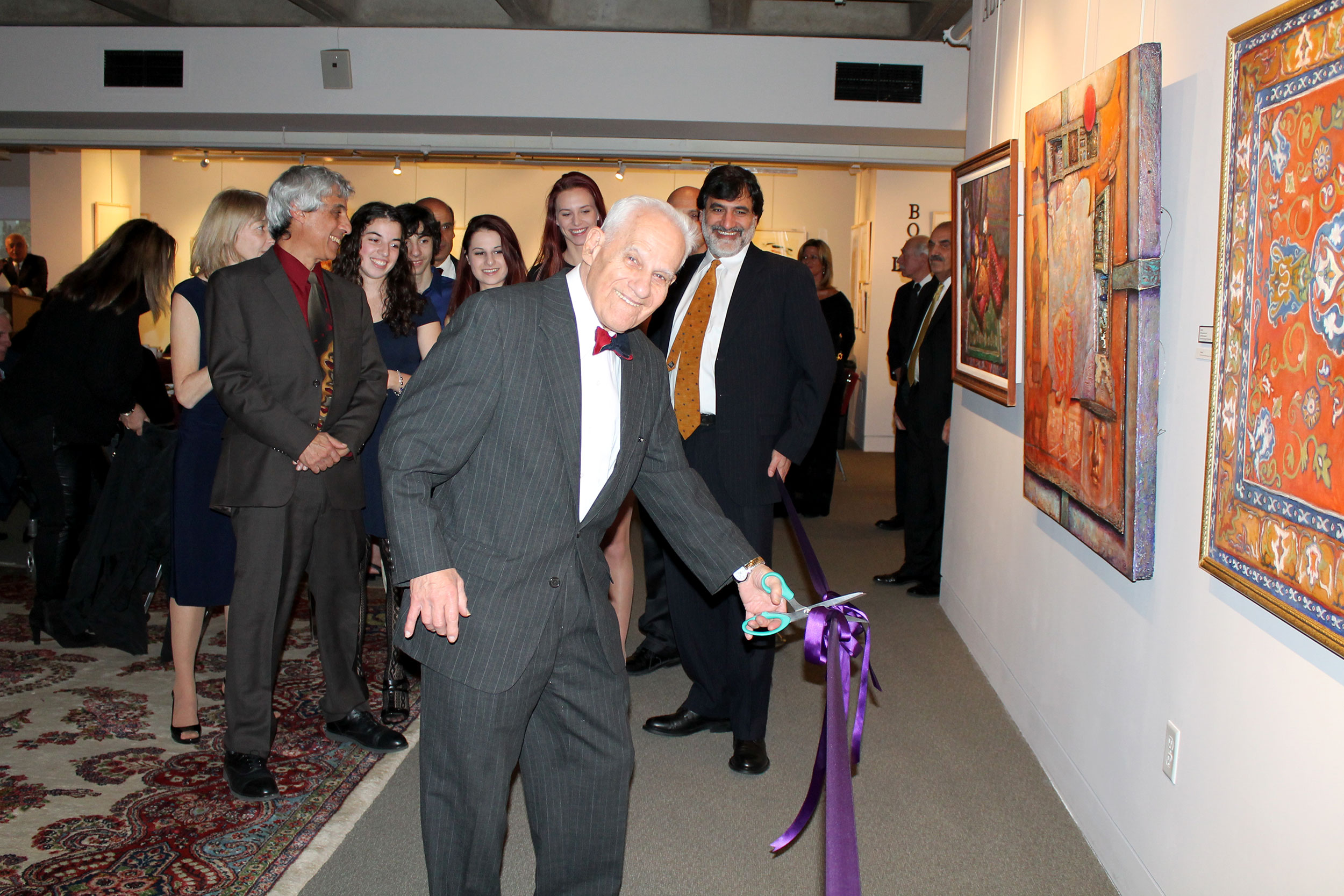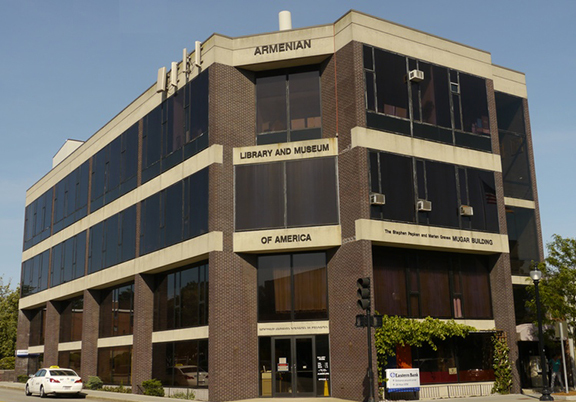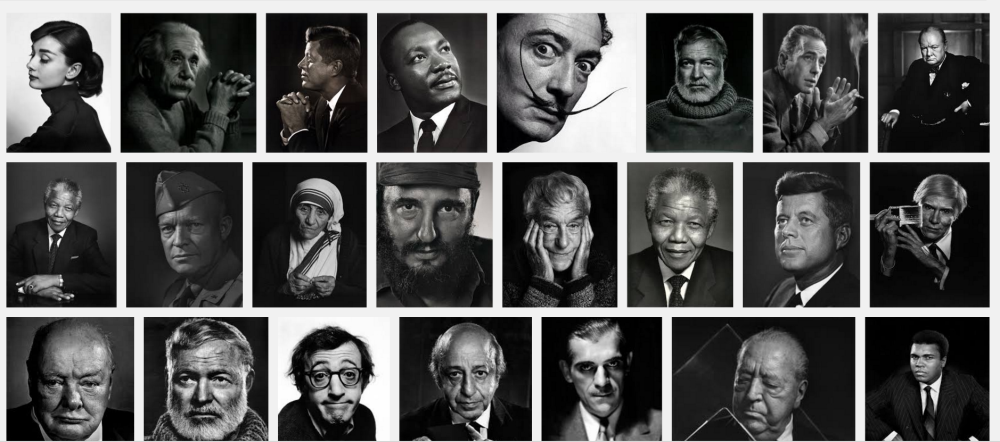Pieces from the Collection of the Armenian Museum have been making their way into numerous exhibitions around Boston over the past few months. It has been so exciting to know these incredible objects from ALMA are being featured in other exhibitions, and being shared and appreciated with even more people in the area. At the end of last year, we were one of 19 institutions that took part in the Beyond Words exhibition, and this spring we have an object from our Genocide collection on loan at the Museum of Fine Arts.
ALMA Curators Gary & Susan Lind-Sinanian and Collections Manager Susanna Fout with the Canon Tables at Houghton Library
Beyond Words - Houghton Library at Harvard University
Beyond Words: Illuminated Manuscripts in Boston Collections was the first exhibition to showcase highlights of illuminated manuscripts in the Boston Area. An ambitious collaborative project among area museums, Beyond Words was notable for the size of its curatorial team, the number of lending institutions, and a multi-venue display.
The exhibition presented more than 260 exceptional manuscripts and printed books from 19 Boston-area collections, dating from the ninth to the seventeenth centuries. The three displays -- one at the Isabella Stewart Gardner Museum, one at the McMullen Museum at Boston College, and one at the Houghton Library at Harvard University-- each covered a different time frame and purpose for illuminated books.
The Armenian Museum was honored to be one of the area institutions asked to contribute to the Houghton portion of the exhibition, which focused on the centrality of books to monastic life (open September 12-December 10, 2016), and our fifteenth-century Canon Tables (Acc. 1986.846) was included.
The exhibition was supplemented by an extensive catalog, which featured the Canon Tables and another of our rare books, The Garabed Gospel.
During the last week of the exhibition, ALMA Staff members attended a Curator's tour program with Houghton curators William P. Stoneman and Anne-Marie Eze. Staff learned more about the planning process of the Beyond Words exhibit (which took 20 years to plan!), behind the scenes information about the Houghton Library's role, and the exhibition design work involved.
Objects of Witness and Resistance in conjunction with Memory Unearthed - Museum of Fine Arts
This spring the Armenian Museum has an artifact included in the MFA exhibition, "I must tell you what I saw" - Objects of Witness and Resistance. Officially open to the public on March 30, 2017, this special installation in the Linde Family Wing includes objects and works of art that bear witness to the destruction and silencing of specific people groups, through violence, genocide, persecution and fear.
A twentieth century chalk mold chosen from the Armenian Museum's collection is one of nine objects featured in the exhibition. Also included are: a painting by Armenian Genocide survivor Arshile Gorky, an ancient Assyrian relief depicting the deportation of the Babylonians, J.M.W. Turner's Slave Ship (1840), and a nineteenth century Chinese vase that was painted over during the Chinese Cultural Revolution to protect it from destruction.
All the objects in the display are hauntingly connected by an exerpt from "The Dance" by Siamanto (Atom Yarjanian, 1910) , an Armenian poet executed in a purge of intellectuals during the Armenian Genocide.
"Don't be afraid; I must tell you what I saw so people will understand the crimes men do to men"
The chalk mold in the exhibition on loan from ALMA was originally owned by Krikor Ouzounian, who persuaded the Ottoman army to spare him and his family during the Armenian massacres of 1894-96 by offering to make chalk for the Turkish Army. Ouzounian built a secret room when his factory expanded where he hid his family at the onset of the Armenian Genocide in 1915.
Ultimately, Ouzounian perished during the Genocide, but his wife and other family members survived. When they were able to escape to the United States, they brought the chalk mold with them as a reminder of their former life and the means by which they were able to escape execution.
In conjunction with this exhibit in the Linde Family Wing is Memories Unearthed: The Lodz Ghetto Photographs of Henryk Ross.
Second in Jewish population only to the Warsaw ghetto in German-occupied Europe, the Lodz, Poland ghetto was inhabited by more than 160,000 people when it was first occupied by German forces in 1939. Henryk Ross was one of those confined to the ghetto in 1940 and, as a photojournalist, was given role of bureaucratic photographer in one of the Nazi-regime controlled departments running the city.
Unofficially, and at great risk to himself, Ross was able to capture more than the bureaucratic ID cards and propaganda shots that the Nazis had ordered. Through his lens, Ross captured the brutal everyday realities, including starvation and hard labor, of life in a Hitler-designed ghetto. In an effort to preserve his photographs, Ross buried the negatives in 1944. One of 867 survivors, Ross returned after the liberation of Lodz by Soviet troops to unearth his memories.
Memory Unearthed presents more than 200 of Ross’s powerful photographs, comprising a moving, intimate visual record of the Holocaust. The images are accompanied by artifacts, including Ross’s own identity card, and ghetto notices. An album of contact prints, handcrafted by Ross and shown in its entirety as the centerpiece of the exhibition, serves as a summation of his memories, capturing his personal narrative. -MFA
On display until July 30th of this year, these powerful MFA exhibitions are a great visit choice during the month of April, which is Genocide Awareness and Prevention Month.
We are greatly honored to have been included in both of these exhibitions, and if you're eager to see even more of our collection and learn more about Armenian history, art and culture, be sure to visit our Museum in Watertown, MA. With three floors of exhibition space to explore and a collection spanning more than thirty centuries of material, we have something for everyone!




















